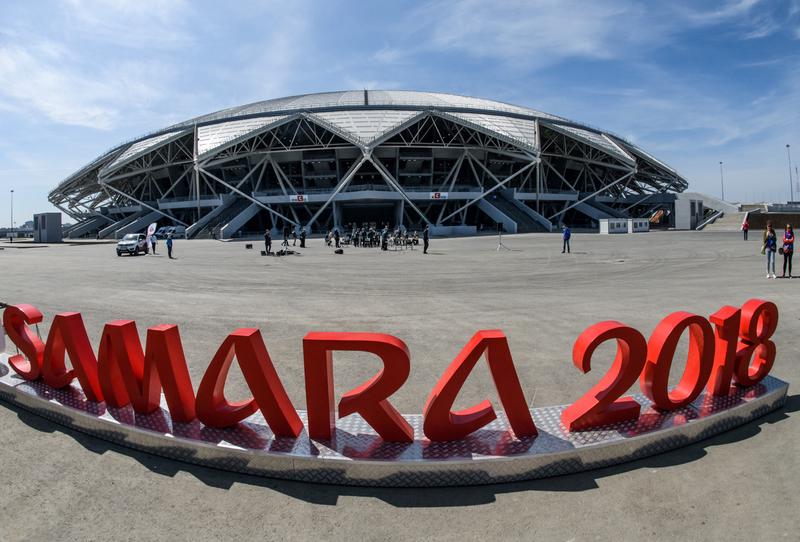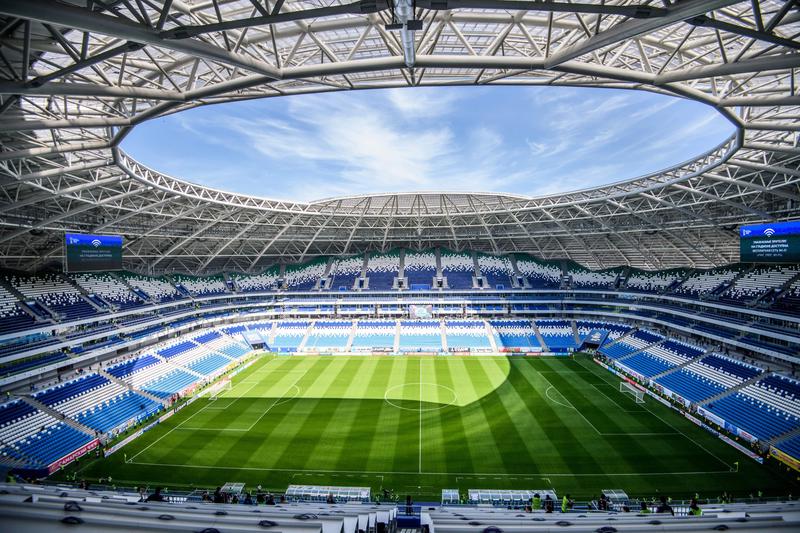The Samara Stadium is an ode to the city's contribution to the aerospace development of Russia.
This piece is the latest in a series in which we have analyzed the most beautiful stadiums of the Russian World Cup. The first three are Luzhniki, Nizhny Novgorod, and the Otkritie Arena.
On the Cosmos Arena were played:
Costa Rica-Serbia (Group A), 17 June 2018
Denmark-Australia (Group C), 21 June 2018
Uruguay-Russia (Group A), 25 June 2018
Senegal-Colombia (Group H), 28 June 2018
Brazil-Mexico, 2 July 2018
And they will be played:
quarter-final 1F-2E/1H-2G, July 7, 2018

"Roger. I feel good, the morale is excellent. Ready to go. It is 9:07 a.m. on the morning of April 12, 1961, in Moscow, and Yuri Gagarin pronounces these words, at the beginning of the countdown called from the operating room of the Cosmodrome of Bajkonur (location of the then Soviet Union, today in Kazakhstan). The Soviet astronaut, inside the Vostok 1 capsule, is preparing to become the first man in history to be launched into orbit. 1500 kilometers away from Baikonur, in a north-westerly direction, there is Samara, the sixth largest city in Russia which, at the time of Gagarin's launch and until 1990, was called Kuibyshev.
It was in Samara that the Vostok 1 spacecraft was built. The city, situated at the confluence of the Volga and the River of the same name, has always been one of the most important centers of aerospace development in Russia and the Soviet Union. Here you will find the "Samara Kosmicheskaya", the Museum of Aviation and Space, founded in 1977. But this year another building will celebrate the role of Russia in the space race: the stadium "Cosmos Arena", built specifically for the World Championships of Russia 2018.

Krylya Sovetov
The Cosmos Arena is not the first stadium in Samara, which has been living on football since the 1940s. In 1942 Krylya Sovetov was founded, taking its first steps with the Soviet League cup matches, the Kubok SSSR. In 1961, as Gagarin flies into orbit, Krylya wins promotion to Klass A, the then premier division championship of the Soviet Union.
At that time the team (whose name in Russian means "the wings of the Soviets") had already been playing for four years at the Metallurg Stadium, initially the field of the youth selection. The stadium was built in a few months, with material from the local factory named after Lenin, and will see the first modernization work only in the 70s with the abandonment of the wooden steps and the appearance of reinforced concrete.
Equipped with an indoor gym with a regular basketball and volleyball field (making it an atypical stadium, with only three bleachers on either side of the pitch), it has been Krylya's playground to date, hosting preliminary rounds of the Champions League and Europa League in the early 2000s. In 2012, two years after the award of the World Cup in 2018, the certificate of excellence awarded by the Russian Federation to the Metallurg Stadium expires, although Samara is confirmed on the list of the host cities.
The first idea is, therefore, to build the new stadium on an island outside the city, on the Volga river. A project as fascinating as it is unrealizable, as well as the other hypothesis, the one that plans to build it near the city airport (Samara is an important communication hub of Russia but the airport is almost 50 km from the city center).

The final choice, therefore, an area just north of the town, 10 minutes from the old Metallurg Stadium and along the highway in the direction of Moscow. Designed by the German firm GMP Architekten in Hamburg, with the consultancy of Aecom, the Cosmos Arena was inaugurated on 28 April, with a friendly match between Fakel Voronež and Krylya Sovetov (a local club for which will also become the home stadium) and is revealed as a tribute to the city of Samara and its fundamental contribution to the aerospace development of Russia.
Architecture
The distinctive character of the facility is the shell shape, evoking the appearance of a spaceship and celebrating Samara's aerospace tradition. A classic form of dome stadiums, one of the most famous of which is Houston's Astrodome - another city with a certain tradition of orbiting. It took four years of work (and delays) to complete the Cosmos Arena, which came just a month before the start of the World Cup. Delays due to contradictions and disputes over the design of the stadium, its construction and costs.
The structure of the large dome roof should have been made of semi-transparent material: the intersections of the supporting trusses, suitably lit, would have increased the scenic impact and the reference to aerospace technology. On the contrary, the choice then fell on a continuous steel cladding that envelops the stadium completely and ends up on the ground in a series of inverted triangles that give the idea of a structure "in the take-off phase".
The maximum height reached by the dome is 60 m at its central point, where there is an oculus that allows the entry of the light into the stadium. Inside, the structure of the stadium is a classic rectangle that embraces the playing field, almost independent of the external circular dome that wraps it with a glass bell effect.

In the interior spaces created between the steps and the external dome, there are a series of shops whose installation was wanted mainly by local institutions. This decision not only delayed the construction schedule but also enlarged the size of the stadium to cover an area of 156,000 square meters - almost 40% more than the original project.
The capacity, however, has remained unchanged and the stadium can accommodate 45,000 people, arranged on two rings of continuous stairways around the field, separated by a band in which are placed the boxes and the stages. The internal profile is undulated, as in the style of contemporary stadiums: the sine wave finds its highest points in the center of the stands, then descends at the corners and avoid as much as possible the presence of places far from the field. Moreover, the curve is not continuous but serrated, with the repetition of "tips" that replicate the external triangles with which the dome of the cladding ends on the ground. The two structures, external and internal, dialogue with each other despite the strong contrast of the forms, increasing the sense of recollection inside the stadium.
The Cosmos Arena embodies the unique features of a design that renews those of large indoor dome systems but also finds a way to convey an idea of modern intimacy, in a perfect sporting tribute to the space race that has marked the history of the city of Samara and Russia.
Comments